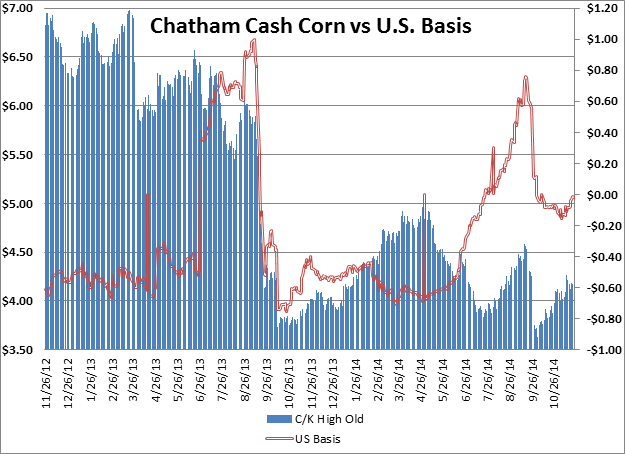Looking at the basis
FINDING THE MARKETING MESSAGE
 BASIS IS WHAT we collect at Farm Market News each and every day. Without sounding too basic, let’s set the stage for this fairly simple concept. First of all, the trade in Ontario uses two numbers to come up with the final price for corn, soybeans, and wheat. They are the price from Chicago in U.S. currency and the basis in Canadian currency. This basis is made up of the following elements: transportation between Chicago and the Ontario location, the Canadian dollar exchange rate, and a handling fee. We call this the ‘unadjusted basis’.
BASIS IS WHAT we collect at Farm Market News each and every day. Without sounding too basic, let’s set the stage for this fairly simple concept. First of all, the trade in Ontario uses two numbers to come up with the final price for corn, soybeans, and wheat. They are the price from Chicago in U.S. currency and the basis in Canadian currency. This basis is made up of the following elements: transportation between Chicago and the Ontario location, the Canadian dollar exchange rate, and a handling fee. We call this the ‘unadjusted basis’.
There is also another variable in this basis — local demand. It is hard to see local demand if you watch the unadjusted basis. You have to strip out the exchange rate and get this to a true U.S. basis or ‘adjusted’ basis. The U.S. basis is calculated by dividing your cash price by the day’s exchange rate and then subtracting the Chicago futures price.
For example, the day’s current Chatham cash corn price is $4.125 / bushel (bu). The exchange rate is 1.1282. Chicago is 3.675. In math terms it looks like this: (4.125/1.1282) – 3.675 = – 0.0187.
In other words, the U.S. basis in Chatham is two about cents under the Chicago price. And since Ottawa took the penny away, we can call this even with Chicago’s value. Do you think there is a message in that? As we write this at the end of November, half of Ontario’s corn is still out in the field and after some strong winds coming from Chicago’s direction, half of that is on the ground. The message from this math demonstration is that demand is strong during this harvest season.

Looking back a year or so can help when looking ahead to the coming year’s markets. Using this little tool of U.S. basis calculation, look at the graph below and see what messages are in it.
While the graph has a couple of hiccups in it because of contract month changes, there is a clear message. While corn prices were in the stratosphere until June of 2013, the basis did not have to buy corn — Chicago did. But when the farmers ceased selling and the drought talk heated up, the adjusted basis went through the roof!
Looking further along during harvest 2013 into 2014, when reality set in, corn prices went to the cellar. But by June 2014, Ontario processors started hefting up their local cash corn basis when they saw how expensive U.S. corn was to import. Meanwhile, Ontario farmers were reluctant to let go of ownership as Chicago kept tanking. See what happens to that adjusted basis — back up to plus $0.80. Clearly market signals were at work there.
Now, let’s go back to our previous example. With a U.S. basis at even, and Chicago heading higher, short term forecasting is easy. The market wants corn and is telling growers. If we were to stick our necks out even further, it looks like a safe bet that the U.S. basis line will keep climbing.
It will be valuable to continue to watch these market signals as we follow this crop in 2015. •
John Jordan is editor of Farm Market News and AgriLink. Jordan draws his knowledge of farm markets from his 43 year career in agricultural journalism. Hired by the Ministry of Agriculture and Food in 1991, he helped stick-handle the Farm Market News programming into the computer age. Based at the Ridgetown Campus of the University of Guelph, he conducts market research in ag commodities and publishes daily digests of market news for Ontario farmers. One of his key clients is Grain Farmers of Ontario. Primary market reports cover prices for corn, soybeans, and wheat, with secondary reports on hogs, cattle, sheep, lambs, and goats.


















